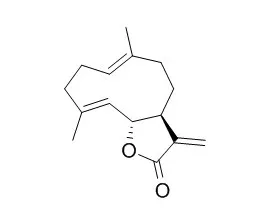| Description: |
Costunolide has antipyretic, anti-inflammatory, anti-oxidant, anti-carcinogenic and anti-fungal activities, it possesses normo-glycemic and hypolipidemic activity. Costunolide inhibits RANKL-induced osteoclast differentiation by suppressing RANKL-mediated c-Fos transcriptional activity; it inhibits IL-1beta gene expression by blocking the activation of MAPKs and DNA binding of AP-1; it also induces the ROS-mediated mitochondrial permeability transition and resultant cytochrome c release, |
| In vitro: |
| Phytother Res. 2014 Oct;28(10):1499-505. | | In vitro and in silico evaluation of NF-κB targeted costunolide action on estrogen receptor-negative breast cancer cells--a comparison with normal breast cells.[Pubmed: 24733523] | Costunolide, a sesquiterpene lactone is a plant-derived secondary metabolite found to be present in most of the pharmacologically active herbs, being the cause for their medicinal values. The present study aims to evaluate the cytotoxic effect of Costunolide isolated from Costus speciosus rhizome extract on MDA-MB-231 cells and explore its targeted action in comparison with its action on the normal breast cells (MCF 10A).
METHODS AND RESULTS:
The effect of Costunolide on cell viability of the cells was assessed by 3-(4,5-dimethylthiazol-2-yl)-2,5-diphenyltetrazolium bromide viability assay. The targeted action of the compound was analyzed comparing the effectiveness of the compound to alter the protein expression levels of NF-κB subunits in the normal and the cancer cells using western blotting analysis. In silico studies were performed to predict the targeted interaction of Costunolide with the NF-κB subunit proteins. Costunolide inhibited the cell viability of MDA-MB-231 cells in a dose-dependent manner leaving no significant change in the viability of the normal breast cells. The over expressed NF-κB subunits - p65, 52 and 100 in the cancer cells were found to be downregulated when treated with Costunolide at an effective dose of 20 and 40 μM Costunolide. In silico results provided stable interactions between Costunolide and the target proteins, supporting the in vitro results in addition.
CONCLUSIONS:
Thus, Costunolide derived from C. speciosus plant source elevates a fresh conviction for its use in breast cancer therapy for its cytotoxic efficacy and non-toxic nature. | | Biochem Biophys Res Commun. 2004 Jan 2;313(1):171-7. | | Costunolide inhibits interleukin-1beta expression by down-regulation of AP-1 and MAPK activity in LPS-stimulated RAW 264.7 cells.[Pubmed: 14672714] | Costunolide, a sesquiterpene lactone isolated from the root of Saussurea lappa Clarke, is known to have a variety of biological activities, including anti-carcinogenic and anti-fungal activities.
METHODS AND RESULTS:
Here, we demonstrated the inhibitory effect of Costunolide on the protein and mRNA expression of interleukin-1beta (IL-1beta) in LPS-stimulated RAW 264.7 cells. We also showed that Costunolide suppressed the transcriptional activity of the IL-1beta promoter. Moreover, Costunolide inhibited the activity of AP-1 transcription factor, and the phosphorylation of MAPKs, including SAPK/JNK and p38 MAP kinase. The inhibitory effect of Costunolide on AP-1 activity was also confirmed by an electrophoretic mobility shift assay. Additionally, specific inhibitors of SAPK/JNK and p38 MAP kinase, SP600125 and SB203580, also suppressed LPS-induced increase in IL-1beta gene expression and AP-1 DNA binding.
CONCLUSIONS:
Taken together, these results demonstrate that Costunolide inhibits IL-1beta gene expression by blocking the activation of MAPKs and DNA binding of AP-1 in LPS-stimulated RAW 264.7 cells. | | 2019 Jun 14;20(12):2926. | | Costunolide-A Bioactive Sesquiterpene Lactone with Diverse Therapeutic Potential[Pubmed: 31208018] | | Sesquiterpene lactones constitute a major class of bioactive natural products. One of the naturally occurring sesquiterpene lactones is Costunolide, which has been extensively investigated for a wide range of biological activities. Multiple lines of preclinical studies have reported that the compound possesses antioxidative, anti-inflammatory, antiallergic, bone remodeling, neuroprotective, hair growth promoting, anticancer, and antidiabetic properties. Many of these bioactivities are supported by mechanistic details, such as the modulation of various intracellular signaling pathways involved in precipitating tissue inflammation, tumor growth and progression, bone loss, and neurodegeneration. The key molecular targets of Costunolide include, but are not limited to, intracellular kinases, such as mitogen-activated protein kinases, Akt kinase, telomerase, cyclins and cyclin-dependent kinases, and redox-regulated transcription factors, such as nuclear factor-kappaB, signal transducer and activator of transcription, activator protein-1. The compound also diminished the production and/expression of proinflammatory mediators, such as cyclooxygenase-2, inducible nitric oxide synthase, nitric oxide, prostaglandins, and cytokines. This review provides an overview of the therapeutic potential of Costunolide in the management of various diseases and their underlying mechanisms.
Keywords: anti-allergic; anti-inflammatory; anticancer; antidiabetic properties; antimicrobial; antioxidants; bone regenerating; Costunolide; hair growth promoting; neuroprotective. |
|
| In vivo: |
| J Ethnopharmacol. 2009 Jul 30;124(3):369-76. | | Antipyretic and anti-inflammatory properties of the ethanolic extract, dichloromethane fraction and costunolide from Magnolia ovata (Magnoliaceae).[Pubmed: 19524658 ] | Magnolia ovata (A.St.-Hil.) Spreng (formerly Talauma ovata), known as "pinha-do-brejo" or "baguaçu", is a large tree widely distributed in Brazil. Its trunk bark has been used in folk medicine against fever. However, no data have been published to support the antipyretic ethnopharmacological use. This study investigated the antipyretic and anti-inflammatory effects of the ethanolic extract (EEMO), dichloromethane fraction (DCM), and the isolated compound Costunolide.
METHODS AND RESULTS:
The antipyretic and anti-inflammatory activities were evaluated in experimental models of fever and inflammation in mice.
The oral administration of EEMO, DCM and Costunolide inhibited carrageenan (Cg)-induced paw oedema (ID(50) 72.35 (38.64-135.46) mg/kg, 5.8 (2.41-14.04) mg/kg and 0.18 (0.12-0.27) mg/kg, respectively) and was effective in abolishing lipopolysaccharide (LPS)-induced fever (30 mg/kg, 4.5 mg/kg and 0.15 mg/kg, respectively). EEMO was also effective in reducing cell migration in the pleurisy model. Intraplantar injection of Costunolide also reduced the paw oedema, myeloperoxidase and N-acetyl-glucosaminidase activity induced by Cg in mice.
CONCLUSIONS:
Collectively, these results show, for the first time, that extracts obtained from Magnolia ovata possess antipyretic and anti-inflammatory properties, and Costunolide appears to be the compound responsible for these effects. |
|






 Cell. 2018 Jan 11;172(1-2):249-261.e12. doi: 10.1016/j.cell.2017.12.019.IF=36.216(2019)
Cell. 2018 Jan 11;172(1-2):249-261.e12. doi: 10.1016/j.cell.2017.12.019.IF=36.216(2019) Cell Metab. 2020 Mar 3;31(3):534-548.e5. doi: 10.1016/j.cmet.2020.01.002.IF=22.415(2019)
Cell Metab. 2020 Mar 3;31(3):534-548.e5. doi: 10.1016/j.cmet.2020.01.002.IF=22.415(2019) Mol Cell. 2017 Nov 16;68(4):673-685.e6. doi: 10.1016/j.molcel.2017.10.022.IF=14.548(2019)
Mol Cell. 2017 Nov 16;68(4):673-685.e6. doi: 10.1016/j.molcel.2017.10.022.IF=14.548(2019)